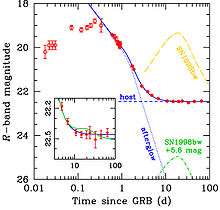GRB 060614
 | |
| Other designations | GRB 060614 |
|---|---|
| Event type | gamma-ray burst |
| Detection | |
| Date | 14 June 2006 |
| Duration | 102±1 second |
| Instrument | Swift Gamma-Ray Burst Mission |
| Location | |
| Constellation | Indus |
| Right ascension | 21h 23m 27.0s |
| Declination | −53° 02′ 02″ |
| Distance | 1.6 × 109 light years |
| Redshift | 0.125±0.001 |
| Source | [PBF2006d] Host Galaxy |
| Energetics | |
| See also | |
|
| |
| Wikimedia Commons has media related to GRB 060614. |
| Wikinews has related news: Astronomers witness supernova |
GRB 060614 was a remarkable gamma-ray burst (GRB) detected by the Swift satellite on June 14, 2006 with puzzling properties, which challenge current progenitor models.[1]
In particular, the lack of any bright supernova (SN) down to very strict limits and the vanishing spectral lags during the whole burst are typical of short GRBs, strikingly at odds with the long (102s) duration of this event and its origin in a galaxy 1.6 billion light years away in the constellation Indus.[2]
In 2011, it was hypothesised that the burst was a white hole appearing for 102 seconds.[3]
As of December 2006, more than a dozen telescopes, including the Hubble Space Telescope and large ground-based observatories, have studied the burst.
References
- ↑ "White Holes: An Impossible Possibility". SciShow Space. SciShow. 6 May 2014.
- ↑ Retter, Alon; Heller, Shlomo (2011). "The Revival of White Holes as Small Bangs". arXiv:1105.2776v1
 [physics.gen-ph].
[physics.gen-ph]. - ↑ Steve Nerlich (23 May 2011). "Small bangs and white holes". phys.org.
External links
Coordinates: ![]() 21h 23m 27.0s, −53° 02′ 02″
21h 23m 27.0s, −53° 02′ 02″